A digital-to-analog converter (DAC) is more prone than an analog/digital converter to signal degradation. DACs are complex devices requiring precisely matched components. For this reason, with notable exceptions, DACs are implemented as mixed-signal ICs based on MOSFET technology. Discrete component DACs are found in radar systems and high-speed test equipment including digital sampling oscilloscopes.
Digital sampling may introduce quantization error that appears as noise in the reconstructed signal. It is here that we find DAC more problematic than the smooth-flowing ADC. DACs must be evaluated based on numerous criteria that generally include resolution, speed, dynamic range, SFDR (spurious-free dynamic range), ENOB (effective number of bits), and SNR (signal to noise ratio). One quality unique to DACs is the undesirable image signals appearing within each Nyquist zone of the output. Other important characteristics include settling time and glitch-impulse area. Settling time refers to the time it takes from the input code application until the output arrives at, and remains within, a specified error band around the final output voltage
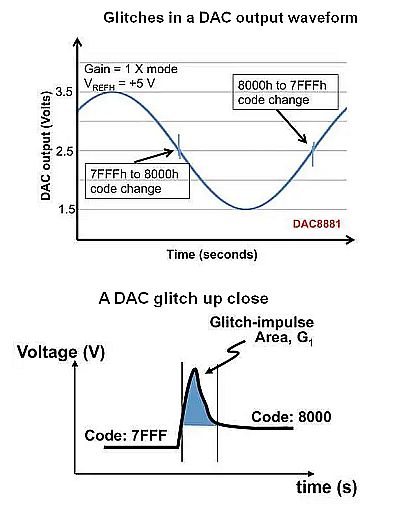
ENOB is significant in establishing the real-world dynamic range of an DAC and arises from noise within the signal and from the DAC circuity, effectively reducing the DAC’s true resolution, SNR, and dynamic range. Other factors that can cause a real device to deviate from the transfer function of an ideal DAC include offset errors and gain errors (due to temperature fluctuations), differential linearity error, and total unadjusted error (TUE), among others. Clock jitter and thermal noise can trigger further errors deviating from ideal DAC performance.
Glitch-impulse area is another important DAC quality. The glitch impulse is defined as the voltage transient appearing at the DAC output during a “major-carry transition.” It means during a single code transition, a MSB changes from low-to-high while LSBs are changing from high-to-low, or vice versa (i.e., a code transition from 0111 to 1000). The glitch impulse energy is equivalent to the area under the curve on a voltage-time graph. This glitch impulse arises because real circuits don’t move from one conversion value to the next monotonically, thus inducing glitch energy into the output and in turn degrading the DAC SFDR.
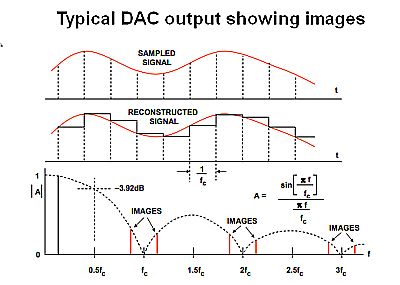
There are two approaches to minimizing glitch energy: Place either an RC filter or a S/H capacitor and amplifier after the DAC. The first approach lengthens settling time, though, while the second approach adds components and PCB space. To eliminate images within Nyquist zones, an anti-imaging filter is generally placed after the DAC.
It is interesting to review what the output of a DAC looks like both when it is working and when there are problems. Suppose we have a four-bit DAC that receives inputs from a four-bit counter that produces a sequence of binary numbers from 0000 to 1111 and then recycles to 0000. Further suppose the DAC produces 1 V for each digit so 1111 (15 decimal) results in a 15-V output. If the DAC works properly, the output display on a scope will be the well-known staircase waveform.
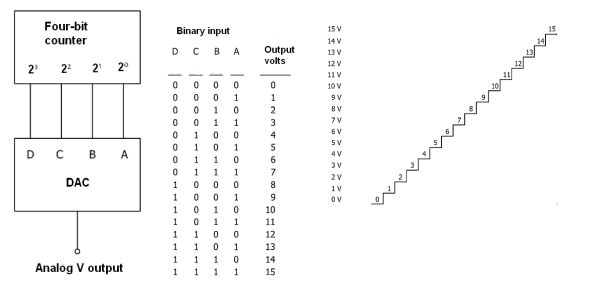
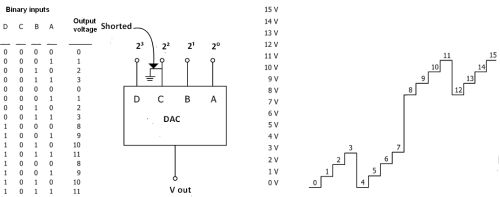
Now suppose one of the DAC inputs is shorted, in this case the input corresponding to the 22 binary value. The most straightforward way of figuring out which input is problematic is to compare the table of analog output voltages vs binary inputs to what’s seen on the scope display. In this case, the analog output voltage is zero at the 22 binary value. This is what’s known as a clue.

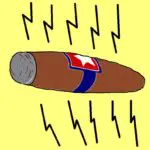




Leave a Reply
You must be logged in to post a comment.